Nasal Saline Irrigation (Sinus Rinse)
Sinus rinse
What is nasal irrigation?
Nasal irrigation uses salt (saline) water to clean out the nose. It is also called a sinus rinse.
How is it done? 
Use a sinus rinse kit or a bulb syringe. A pre-made system may be easier and more comfortable to use than a bulb syringe.


Sinus rinse kits come with single-use salt packets. You can also make your own irrigation solution with this recipe:
- ¼ tsp. kosher or pickling salt. The salt must be iodine-free.
- ¼ tsp. baking soda. Do not use baking powder.
- 8 oz. warm distilled water.
Make fresh solution each day and clean the bottle or syringe and let it air dry.
Distilled water is best. Tap water may not be clean enough. Boil tap water for at least 5 minutes if distilled water is not available. Let it cool. If you boil more water than needed for one rinse, keep the extra water in a refrigerator until you need it. Be sure the water is at room temperature or warmer when you use it. It can be warmed slightly for added comfort.
Use 4 to 8 ounces of solution in each nostril. Do these 1 to 2 times a day, or as prescribed by the health care provider. This can also be done in the shower for less mess.
Breathing through the mouth during the rinse will prevent a mess. It will also reduce the amount that goes into the throat. Use just enough pressure to move the solution to the back of the nose so it comes out through the mouth or nose. This should not cause major discomfort once you are used to it.
Directions
- Lower your head over a sink.
- Squeeze solution from the container into the one nostril.
- Saline and nasal drainage will drain from the other nostril into the sink.
- Gently blow your nose.
- Repeat the same process for the other nostril.
If using a Neti pot, tip your head to one side. The fluid goes in the top nostril and comes out the bottom. Tip head the other way and repeat for the other nostril.



